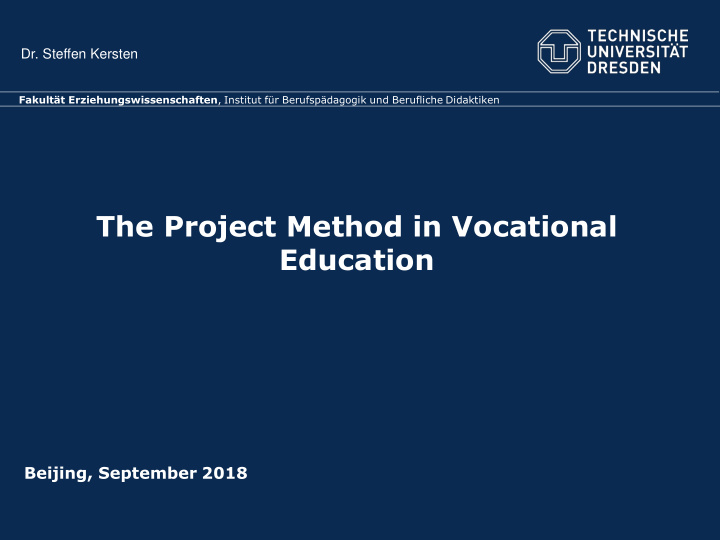



Dr. Steffen Kersten Fakultät Erziehungswissenschaften , Institut für Berufspädagogik und Berufliche Didaktiken The Project Method in Vocational Education Beijing, September 2018
Working with Projects - History “Project Work is planned action (single-handed) heartfelt (interests, necessities) that takes place in a social environment” (social responsibility) Kilpatrick: The Project Method. Teachers College Report 1918, 19 S.319-335 Folie 2
Projec ject t Meth thod afte ter r Kilpatric trick/ / Dewey wey 1. Starting with an obvious problem from the surroundings of the participants (where does typhoid come from?) 2. Location, precise statement - general educational goals - educational relevance of action given in part through the problem, planning and experiment 3. Problem solving approaches constructing a plan for solution finding, therefore precision of the target objective 4. Simulation of solution possibilities imaginary implementation of the plan 5. Experimental proof - carrying out the plan as problem solution or construction of the product - when required coordinated labor distribution - practical implementation and use of results cp. Frey, Karl: Die Projektmethode. Weinheim, Basel 1991 Folie 3
Chara racte teris ristic tics of projec ject work from a didactic tic point int of view 1. A project is existent. 2. The work on the project requires structures of solving problems. 3. Project work is oriented at the experiences and interests of the learners. 4. Project work is characterised by complete learning acts. 5. Project work is coined largely by self-organisation and responsibility 6. Project work is carried out in bigger or smaller groups and also alone. 7. Project work is multidisciplinary and beyond their job. 8. The non concrete project as an objective or subjective utility value. c p. - Gudjons, H.: Handlungsorientiert lehren und lernen.Bad Heilbrunn/Obb. 1989, S.58ff - Frey, K.: Die Projektmethode. Weinheim, Basel 1991, S.15ff - Hortsch, H.: Merkblätter zur Vorlesung. Dresden 1999 Folie 4
Basic ic Patt ttern rn of the Projec ject t Method Project initiative Frey, K.: Die Projektmethode. Analysis of the project initiative Weinheim, Basel 1991 within an earlier agreed framework (direct participants, possible indirect participants) (result = project outline) possible Joint development of the field of activity end (result = project plan) possible (Intensified) activities in the field of activity/ carrying out the end project (single, in subgroups, with the whole group) In the course of the Completion through intentional ending (1) or through feed back to the project insert Project initiative (2) or through phasing out (3) - fixed points direct or indirect participants, possible new target group - meta interactions intentional ending feed back to the Project initiative Folie 5 phasing out
Basic Pattern n of the Projec ect Method 项目构思 在达成协议的框架中讨论项目计划 (直接参与、间接参与) (结果 = 项目草案) 有可能结束 共同探讨开发实践领域(也有间接的参与) (结果 = 项目计划) 有可能结束 实践领域的行为活动 / 项目实施(个体的、小组的、大组的) 项目过程中的介入 得出结果结束( 1 )或反馈到项目计划( 2 )或是慢慢结束( 3 ) - 基点 直接或间接的参与,也许可能有新的参与者 - 辅助手段 得出结果 反馈到项目计划 费雷 , 卡尔 : 项目教学法 . 慢慢结束 Weinheim, Basel 1991
Analysis of the Project Initiative Criteria for the Analysis of the Project Initiative - Interessen der Lernenden - Bildungswert des Projektes - Realisierbarkeit des Projektes - Gebrauchswert des Produktes The project Outline contains information on - the time limit - the product - the different fields of work (roughly) Folie 7
驱动项目的各种原则 - 学生的兴趣 - 项目的教育价值 - 项目的可行性 - 项目结果的使用价值 项目草案 包含下列各项 - 时间范围 - 要得出的结果 - 研究领域 ( 概括的 )
Example Project Outline Product: a) power supply unit b) developed and tested circuit for an power supply unit with documentation Duration: a) ca. 10 days b) ca. 5 days Fields of activity: - literature study on transformer, rectifier, - design of circuit - account of components - finding of characteristic curve of components - experimental test of power supply unit - documentation of solution - (making of power supply unit) Folie 9
The Project Plan list of activities distribution of activities among groups and individuals development of a time schedule for each activity qualification objectives ( knowledge, skills) important: the higher aim is not the product but the qualification of the learners Folie 10
项目计划 - 列表各种工作任务 - 将任务分配给各组和个人 - 制作各个任务的时间计划 - 达标目标 ( 知识、能力、技能 )
Example Project Plan activities: 1) designing and dimensioning of transformer and rectifier (day 1 and 2) - … - … - … 2) designing and dimensioning of voltage control (day 3 and 4) - … - … - … 3) experimental test of voltage stability of power supply unit (day 4) - … - … - … 4) completion of documentation / presentation of results (day 5) Folie 12
The End of the Project (1) the intentional end the project work ends with the completion of the product (2) feed back to the project initiative participants compare final result and starting point of the project (3) phasing out the strived for qualifications have been achieved through project work (certain skills, knowledge) cp. Frey, K.: Die Projektmethode. Weinheim, Basel 1991 Folie 13
Problems in the Evaluation of Project Work 1) An exclusive control and assessment of learning outcomes by the teacher isn't possible. 2) Control and evaluation of learning outcomes must be done in collaboration between the learners and the teachers. The starting point for this is the self- ´ control and evaluation of the learners, followed by mutual evaluation of the performances by the students. On this basis, the teacher is able to explain its performance assessment. 3) Despite the product-orientation in learning by working with projects should be the focus of control and evaluation not lie on the quality characteristics of the product, but in the process solving problems.
项目教学法在评估阶段遇到的问题 不应让未参与该项目的教师来评估项目结果。 1) 应由学生和教师共同评估和检测项目结果。 2) 除了学生之间的互评外,学生应自评。在此基础上,教师再给予评价,并作 解释。 尽管在项目教学中强调最后得出结果,但是评估和检测的重点不应仅仅放在 3) 项目所得的结果上,也应放在解决问题的过程上。
Dr. Steffen Kersten Fakultät Erziehungswissenschaften , Institut für Berufspädagogik und Berufliche Didaktiken Thank you for your attention Beijing, September 2018
Recommend
More recommend